#colin gray icons
Text
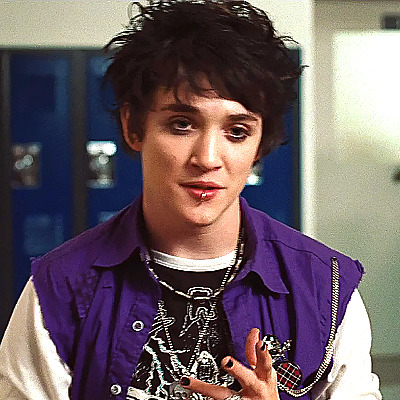
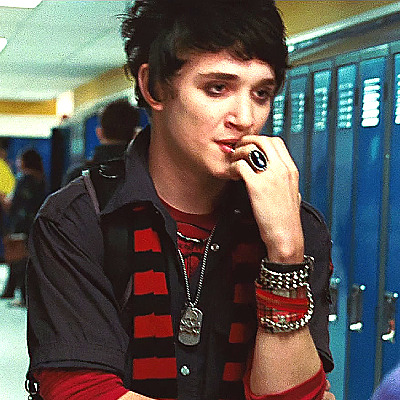
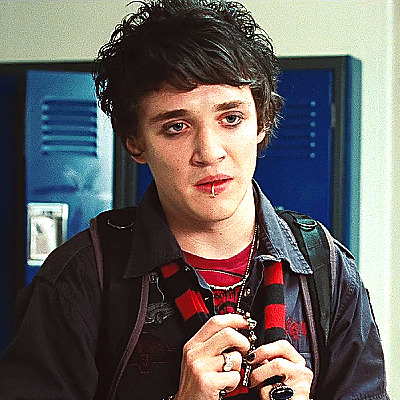
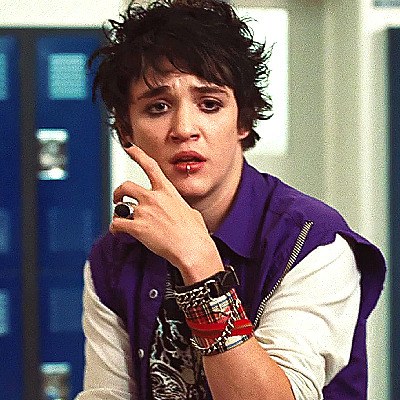


Colin Gray — Jennifer´s Body (2009)
#kyle gallner#kyle gallner icons#kylegallneredit#kgallneredit#colin gray#colin gray icons#jennifers body#jennifers body icons#jennifersbodyedit#screencaps#twitter icons#horror icons#icons without psd#horroredit#icons#movie icons#movieedit#filmedit#00s icons#00sedit
710 notes
·
View notes
Text



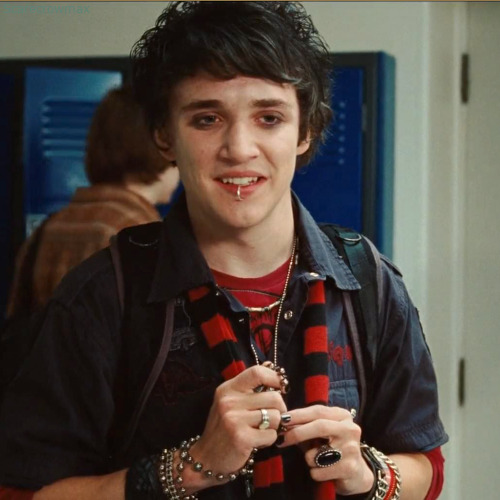
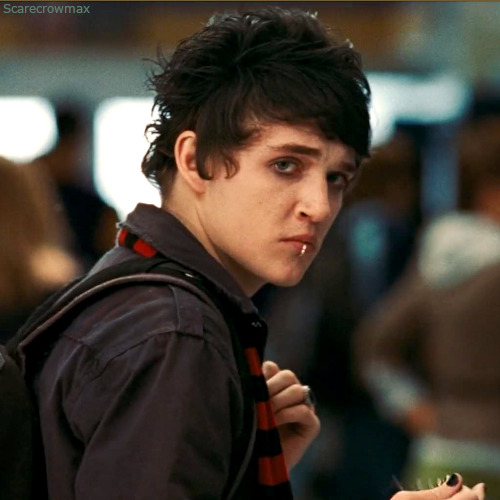
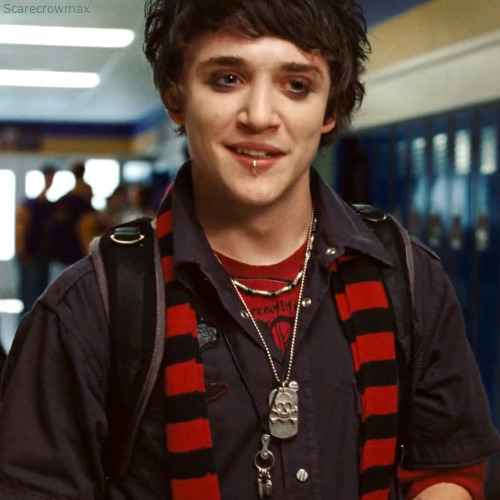





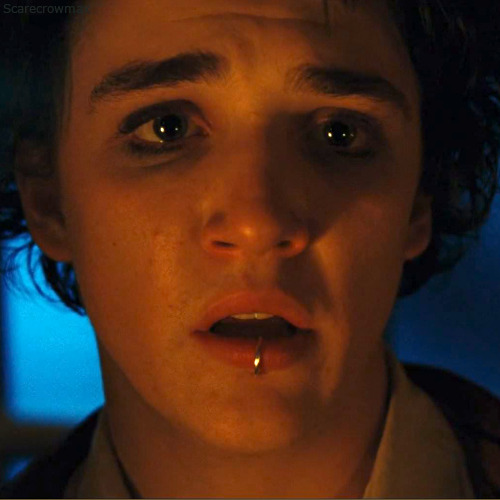
Colin Gray Icons
free to use, credit appreciated but not necessary. if you have a request or want to be tagged for any of my edits send me an ask. don’t repost, reblogs appreciated. all of my edits can be found here
135 notes
·
View notes
Text
The Many Faces of Captain James Hook
With the release of the first promotional images of Jude Law’s Captain Hook for Disney’s upcoming Peter Pan and Wendy, there’s been a lot of complaints about both the costuming choices made and the fact that Law’s Hook bears little physical resemblance to the captain’s more “traditional” look and seems to be older than most versions with his graying locks. Some have even gone so far as to call Law’s Hook “ugly”—which I find rather unfair and even laughable. (If you find Jude Law in any role ugly, your male beauty standards are ridiculously high and I hate to think how hideous you must think most average people are.) Further, it’s a bit shallow to reduce a character completely to his physical attractiveness—especially a character as complex and complicated as Captain James Hook. Barrie’s Hook was described as being handsome, yes, but the popular vision of Hook as being an inherently “sexy” character is a fairly modern phenomenon in the story’s history—probably largely due to Jason Isaacs’ performance in the 2003 Peter Pan and, more recently, Colin O’Donoghue’s “Killian Jones” (who isn’t even technically James Hook) for Once Upon a Time. But the character has existed for close to 120 years, and in that time, he has borne many faces—some instantly recognizable as our favorite captain; others less so. He has worn a variety of colors and clothing styles, had nearly every shade of hair, and possessed varying degrees of facial hair. In fact, you may be surprised to find that the iconic waxed mustache, red coat, and ostrich plumed hat likely didn’t become mainstream until around the time Disney put out their version of the film. (That’s not to say other, previous Hooks didn’t ever have these characteristics. Only that Disney was probably the catalyst that solidified the look into the mind of the fandom.) For those who may not be as familiar with the history of the Hooks, let’s take a quick look at some of the lesser known versions of the character…some of whose influences can still be seen in Law’s Hook.

Here we see the costume design for Captain Hook by William Nicholson for the first production of Peter Pan, Duke of York's Theatre, 1904. You’ll notice the concept art doesn’t feature the bright red coat or any pluming on the tricorn hat.
You can see how this costume idea might have translated onto an actor in this image of one of the earliest actors to play Hook on stage, Robb Harwood.

Notice, he has no facial hair at all and although he looks like a gentleman, he’s far less “frilly” than the standard Hook is today.
The iconic mustache is also conspicuously absent in the silent film’s Hook, played by actor Ernest Torrence. He also still has the tricorn hat without any plumage. Note that Barrie was still alive at the time of the silent film when it came out in 1924, and some of his suggestions made it into the film.
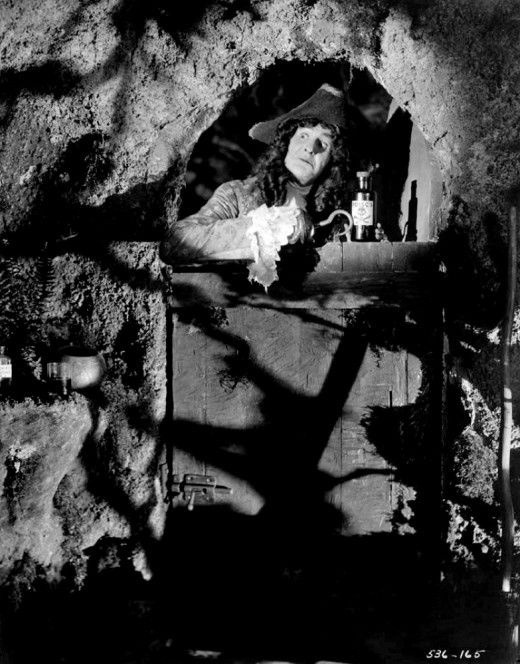
Another early Hook, played by famed horror actor Boris Karloff for the 1950 Bernstein musical looks downright terrifying.
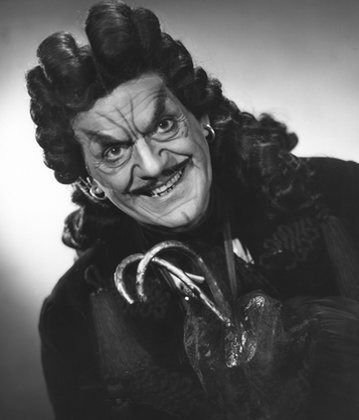
He has the mustache and the hair going on but I don’t know if I’d call him exactly “handsome” here.
Then we get to the 1960s. This seems to be about the time that we get the bicorn hat that Law’s Hook wears in the promotional photo. It shows up both in some scenes with Cyril Ritchard’s version of the character (notably, Ritchard was in his 60s when the film version was recorded, and his Hook has gray hair)—though he also has the red plumed hat we associate with most modern Hooks—and in Vincent Price’s stage Hook (sadly, not recorded to my knowledge).

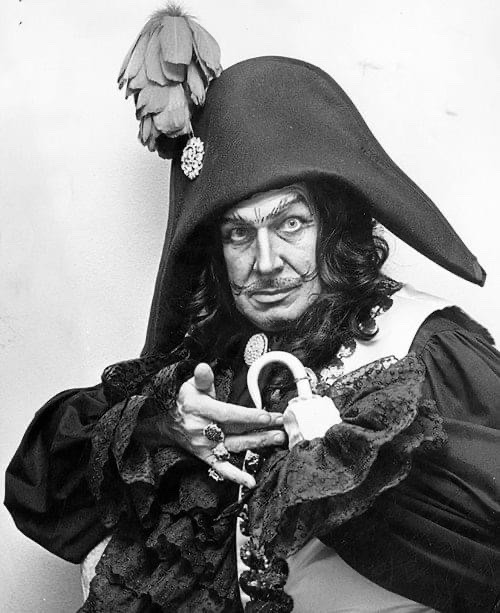
Of course, we also get Disney’s version of Hook in 1953, and after that, we start to see more of the “iconic” Hook look that we’re used to with a few exceptions, such as Fox’s Hook from the 1990 series Peter Pan and the Pirates, who has white hair, no facial hair, and a dark navy blue/black outfit.

Despite looking more like an angry Quaker Oatmeal man than the usual Captain Hook, this guy gets a lot of love from the fandom because Tim Curry’s voice acting knocks it out of the park and personality wise, his Hook is both refined and threatening.
We also have to remember that even Hoffman’s 1991 version of the captain is likely much older than (and not quite as good looking as) he comes off as when he’s fully made up. Recall the scene near the end when he loses his wig:

And Rhys Ifans’ “prequel” Hook in SyFy’s Neverland (2011) hardly looks like a Hook at all when we first meet him.

Even after his transformation into the pirate we’re more familiar with, he still has the “wrong” hair color and no mustache.

Yet he manages to get the right “feel” for Hook, which makes up for everything else, epitomizing the messed up father figure in Peter’s life, inspiring both our sympathy and revulsion.
My point in saying all of this is not to explicitly praise Law’s Hook or make any kind of judgement—for that, we’ll have to see the film itself—but to simply remind folks that Hook has worn many faces over the years, and ultimately, what he looks like matters less than the actor and director’s grasp of who he is as a person. Hook, as a fan favorite, has some incredibly large boots to fill and whether or not Law will live up to those expectations remains to be seen. But let’s give the guy (and his character) a chance to speak for himself before we go judging too much. Some of the greatest Hooks haven’t always looked like what we’d expect him to.
#Captain Hook#jude law#disney live action peter pan#cyril ritchard#boris karloff#Peter pan#vincent price#Robb harwood#ernest torrence#rhys ifans#tim curry#peter pan and wendy#jm barrie#Dustin Hoffman
104 notes
·
View notes
Text
Making every Nancy Drew game Gay™ for pride month
SCK: Hulk and Jake were canoodling in secret
STFD: The culprit is a bitter ex-lover of Rick’s
MHM: Everyone already knows Rose and Abby are girlfriends
TRT: Everyone in this game is gay except Jacques. Unless you headcanon that his fiance is his beard.
FIN: Nick is very anti-cop and super rad. You know what else is rad? Being trans!
SSH: Henrik is trans. Why? Because he’s hot and I said so.
DOG: Sally is a lesbian living her cottagecore dreams
CAR: Everyone in this game can be gay if you just believe
DDI: Katie is clearly a lesbian, which is just another reason why Holt doesn’t like her. He’s already a misogynist so he might as well be a lesbophobe too.
SHA: Okay get this: what if Dirk Valentine was trans.
CUR: James Penvellyn was clearly gay. Like...clearly.
CLK: Josiah Crowley was gay and a drag queen!! This is basically canon tbh
TRN: Fatima is a known lesbian. Gay people enjoy romance novels too!
DAN: I headcanon Jean as gay, mainly because of his glasses
CRE: Quigley is an accomplished scientist and also gay and I respect her for that
ICE: No offense but Bill and Lou were definitely canoodling
CRY: You know how the guy Lamont bought Zeke’s from didn’t want him to change the name, despite his name not being Zeke either? Zeke was his boyfriend.
VEN: Nina and Helena are girlfriends
HAU: What if Kit and Matt also used to date? Adding drama to the drama!
RAN: George is literally right there
WAC: Everyone is gay! Yes I know some of the characters have boyfriends but it’s an all-girls school. They are gay.
TOT: Frosty was clearly always meant to be gay
SAW: Yumi is a high-femme lesbian and she is amazing
CAP: Renate is an elderly woman who seemingly never got married and never had kids. Conclusion? She is ace, just like me!
ASH: Again, George is RIGHT THERE. And so is Deirdre!
TMB: Jamila is a lesbian because she’s beautiful and an icon and incredible and I just *swoons*
DED: Ryan is CLEARLY bisexual, she has the haircut! Also, Gray and Niko were in love, which is unbelievably romantic btw
GTH: Harper was ostracized by her family for her mental health struggles but also because she’s gay. Also, Colin and Jessalyn were each other’s beards.
SPY: Zoe Wolfe is bi because she's hot
MED: GEORGE FAYNE IS RIGHT THERE
LIE: Xenia is a theater kid, which is pretty gay (source: i am a theater kid)
SEA: This is the only game that is already gay
MID: Miss Deirdre Shannon makes a comeback!
24 notes
·
View notes
Video
vimeo
Selected By @guaizine: #Burberry & #PopTradingCompany
The Burberry & Pop Trading Company collection emphasizes a sense of movement through the city after dark, with the iconic Burberry check cast in shades of gray and blurred, while reflective elements deliver high impact in low light. Renowned New York City skate filmmaker Colin Read captures the spirit of the collection as our team riders move through the Amsterdam streets after dark.
2 notes
·
View notes
Text
Sympathy For The Daredevil
By Christine Spines
February 2003
Will a blind lawyer who’s also a crime-fighting vigilante be the next big comic-book movie hero? Ben Affleck and Jennifer Garner slip into some tight leather and angsty attitudes to find out.
Grrrrruunt! Snort. Snort. Snort. Snarling and quivering his way into a state of primal rage, Colin Farrell has taken several giant leaps backward along the evolutionary scale in a matter of minutes. His darting eyes and clipped breath give him the air of a fierce animal just let out of its cage as he waits for a chance to unleash a lethal dose of Bullseye, the manic assassin-for-hire he plays in Daredevil, the latest Marvel comic to spring to the screen. Having worked only about 11 days in three months of shooting, Farrell is happy to have been cut loose onto this set built to look like a cathedral of, well, biblical proportions.
Farrell takes a toke on an imaginary joint, and a few beefy grips laugh cautiously as they ready the set. In this scene, Bullseye shatters a stained-glass window with his boot, grabbing the falling shards and hurling them at his arch-nemesis, Daredevil, the titular blind superhero played by Ben Affleck. When director Mark Steven Johnson (Simon Birch) finally calls action, the 26-year-old actor smashes the window, lands with a thus, and begins frantically grabbing fistfuls of air (the shards will be added digitally), which he hurls with all his might at… nobody. Johnson calls cut. Farrell is exasperated. “What am I doing?” the actor says in his native thick Irish brogue. “Fuckin’ break-dancin’?” He twirls around and slaps his knees and heels like a Thriller-era Michael Jackson. It can’t be a good sign when an actor invokes the deposed King of Pop to describe his performance.
Welcome to the all-guts-no-glory world of comic-book action movies, where the actors playing superheroes and supervillains work themselves into a lather to wage war not with each other but with their inner demons – and the far more fearsome prospect of looking downright silly. But stepping into a costumed action-adventure, especially one as full of nuance and ambiguous morality as Daredevil (blind lawyer Matt Murdock by day, crime-fighting vigilante by night), presents a maddening dilemma for the serious actor. It’s hard to resist the temptation to suit up as an icon of popculture mythology in a world in which Spider-Man has become the fifth-highest-grossing movie ever. How else would a lesser-known comic like Daredevilscore such of-the-moment players as Sexiest Man Alive Affleck, Minority Report’s Farrell, and Alias It Girl Jennifer Garner, who plays Elektra, the woman warrior whose designs on Daredevil are nothing short of love or death? On the other hand, there is that pesky business of the job itself, which, for the serious actor, doesn’t feel very serious at all.
While Farrell pretends to throw glass at an imaginary Affleck, the actual star is being primped and primed for his first shot of the day, on a set several hundred yards away. Extra-careful attention is being paid to his nose, which will be responsible for performing his next scene. Daredevil doesn’t really have superpowers, but, because he’s blind, his other senses are turbo-charged. In this case, of course, he smells danger. Affleck’s top half is in character, clad in a skintight red leather jacket complete with built-in ripples and lather headgear that looks like a low-hanging swim cap with devil horns. His bottom half, in baggy gray sweats, is enjoying some time off in this close-up.
Affleck can’t see a thing through his blind-guy mask and passes the time between takes reeling off one-liners to anyone within earshot. This is the gallows humor of the battle-weary or battle-bored. “How’s this for a look!” the 30-year-old actor says, his nostrils flaring the slightest bit. “I know, I know: You’re a fucking gorgeous bastard!” When the cameras roll, Affleck’s mouth and nose twitch wildly for a maximum of 30 seconds. And then his work is done. Affleck slips off his mask and brushes a hand through his matted hair. “We can use that shot for so many things,” he shouts to Johnson. “Just call it, ‘utility sniffer.’” But without much work to do, Affleck, too, looks both exasperated and exhausted. “This stuff is fun, but it’s hard to go for days without any lines. I think we’re doing a good job here but it’s truly hard to walk around day-in, day-out in the costume and keep the shame at bay,” he jokes wearily, heading back to his trailer. “At this point, that’s what I’m shooting for – the moments when the sky parts and the shame is not longer there.”
There may be no character outside of Hamlet or a Morrissey ballad better suited to capture and capitalize on such storms of actorly angst than Daredevil. From his conception in 1964 by Marvel comics mastermind Stan Lee (The Amazing Spider-Man, X-Men, Fantastic Four), Daredevil’s defining characteristic was not his superhuman abilities but rather his disability. “I had done a lot of different characters and they all had problems,” Lee says. “Spider-Man had romantic and financial problems. The Hulk turned into a monster. So it occurred to me that the biggest problem of all would be a superhero who is blind. He’s not invincible, so he’s very easy to empathize with, and that’s important in a hero or in any character you want to become a franchise.”
Daredevil has always been the comic book world’s equivalent of Tommy Lee Jones or Samuel L. Jackson. He has dedicated fans, an enduring shelf life, and a reputation for quality work in a pop medium not always given to such thoughtfulness. But he’s not a superstar. Still, he has always attracted the genre’s most celebrated writers, notably Frank Miller, who took over the title in the early ‘80s and infused it with an operatic sense of tragedy and romance that hooked a generation of teenagers, including Johnson, Affleck, and filmmaker Kevin Smith (who wrote his own run of the comic in the late ‘90s). Miller created Elektra, a liberated woman warrior for Daredevil to grapple with emotionally and physically, and then he broke the cardinal rule of comics: He killed her. “That really screwed me up as a kid,” says Johnson. “You think that can’t happen. You would never see Lois Lane get gutted by Lex Luthor. But when that does happen, you’ve got to pay attention. You go, ‘Wow, I gotta care about this guy because bullets aren’t going to bounce off his chest.’ You don’t know what’s going to happen.”
Much the same could be said for the commercial fate of Daredevil the movie. As the first comics-based movie to be released since Spider-Man became a phenomenon, Daredevil is left to scale audiences’ steep expectations without a universally recognized character or a feel-good, coming-of-age story line. What the filmmakers are gambling on is the inherent appeal of a superhero with no real powers beyond his heightened sense of moral responsibility, one who reflect the post-September 11 fascination with self-sacrifice and everyday bravery. “Spider-Man raised the bar of what people expect, but this is such a different movie,” says Johnson. “Spider-Man, to me, is always swooping down and catching purse snatchers, saying ‘Here’s your purse, ma’am.’ Superman’s saving the world. This was never about that. This is about a guy trying to keep crime out of his area and do the right thing, and his head’s getting all messed up because of it. He’s supposed to be upholding the law as a lawyer, and then here he is out at night as a vigilante. That’s why it resonates with me. We all find ourselves caught between what’s right and what’s wrong.”
The entire production of Daredevil has also been caught between its own conflicting agendas, determining the right and wrong ways to craft a successful comic-book adaptation. With the exception of the Batman movies, actors of Ben Affleck’s level of stardom are rarely cat as superheroes. From the studio’s point of view, it’s hard to accept that the ever-afflicted Daredevil could be embodied by a six-feet-two movie star with a love for livin’ large and a marriage date with J.Lo. Factor in the rush to bear next summer’s Hulk and the X-Men sequel, X2, into theaters, and one begins to get a sense of the mounting pressures placed on Johnson’s dark-horse superhero. “if this thing works with the soul and depth [inherent to the comic], it’s a great thing for this genre and franchise movies in general,” says producer Gary Foster (Sleepless in Seattle). “That means you can do a movie that’s not just standing tall on its genre but deals with complexity and character and stills appeals [to wide audiences]. If we play our cards right, there’s three or four of these. If [this] one doesn’t do it, we’ve blown an opportunity.”
This auspicious moment, for the 36-year-old Johnson, is the consummation of a lifelong infatuation with a comic-book hero whose cinematic future seemed destined to fall into the hands of a more powerful director. “This is the movie I’ve wanted to make since I was a little kid,” he says. “I used to wait outside of the drugstore in Hastings, Minnesota, for these comics to show up on the truck. I’d be there at 6 A.M. when they’re get there and just obsess over them. [But] I never thought I would get a chance to make this movie. I’m not the obvious choice.”
When Johnson first pitched himself for Daredevil, he had just finished shooting Simon Birch, his adaptation of John Irving’s novel A Prayer For Owen Meany, about a physically challenged kid who enchants a small New England town with his preternatural wit and wisdom. “Simon Birch was my film school,” John says, almost apologetically. “Birch was [training me] to make this movie. But they’re both about handicapped heroes, which is kind of interesting.”
That connection wasn’t all that seductive to the gauntlet of Marvel executives, studio heads, and actors Johnson faced during his six-year crusade to make this movie. His first and in some ways biggest hurdle was Marvel. At the time, the venerable comic company was on the brink of bankruptcy due to bad management and an unwillingness to capitalize on the screen-readiness of their universe of 4,700 characters. Daredevil, as it turned out, had a devoted following among filmmakers, and Chris Columbus (the Harry Potter films) had already optioned the project and written a screenplay for Carlo Carlei (Flight of the Innocent) to direct for Fox. Having heard that Columbus’ script needed serious work, Johnson continued to badger Avi Arad, the president and CEO of Marvel Studios, to let him take a crack.
”They were driving me crazy,” recall Arad, who took the project to Columbia after Columbus’s option expired. “Lucky for mark, I fell in love with him. He was so passionate, and he’s a great writer, and he’s soulful.” No sooner had Johnson got the job than the Columbia deal fell apart over Internet rights. So Arad went back to Fox, and Johnson was once again forced to sell himself as the guy whose passion belied his credits. He scored the writing gig, but directing looked out of reach for him. X-Men had just hit pay dirt, and the studio had its sights set on wooing an A-lister. “The attitude was, we can go get Ridley Scott or Jim Cameron,” recalls Foster. Johnson was so infuriated that he rode his motorcycle over to the studio and sat outside the office of the executive in charge of the production for four hours. “They said, ‘He’s in meetings,’ and I said, ‘I ain’t leaving’,’” recalls Johnson, who had already paid an artist $7,000 of his own money for storyboards. “When I got in, I went off on him for quite a while bout why nobody else was right, and this is my movie and needs to be one vision. And in hindsight, that’s what it took. I think he was terrified.”
”He’d been living and breathing this thing for so many years that it just poured out of him,” recalls the executive in question, Sanford Panitch, president of production at Regency Enterprises, which cofinanced the movie with Fox. “You got excited about Daredevil from him. He just loves it so much. He’d do anything to make a great movie.”
Initially, the concept was to make an emotionally driven action movie – more like a film noir with costumes and martial artistry – for a modest budget of around $50 million. “We were going to do it for cheap,” Johnson says. “And as the cast began to grow…” The first major spurt came when Affleck expressed interest in the title role after being offered the part of Bullseye, the flashy villain role traditionally played by bigger stars (think Jack Nicholson or Jim Carrey in the Batman series). Though Johnson and Foster were aware that Affleck was a Daredevil fan, they had focused on actors who kept lower profiles and price tags. “We had a long conversation with Edward Norton. He knew every detail about this characters,” recalls Foster, who says they also looked at Guy Pearce. “but then Edward calls me up and goes, ‘I just don’t know if I want to wear the suit.’”
Although there was still concern about springing for a movie-star salary, Johnson fought for the actor, whose teenage response to Daredevil had been as intense as his own. “I got into it as an early adolescent and Daredevil mirrored my sense of the world as this operatic place full of weighted decisions and doomed romances and endless combat,” Affleck says. “Doomed romances were something I was thinking about because I didn’t have any. Or when I did, they would be like a week long, and then I’d get a note that said, ‘I break up with you.’ So this was what I thought being a sexy teenager was like.” Still, Affleck was aware that the role might not be anyone’s idea of what a sexy grown man is like. “There was a potential for it to be ridiculous,” says the star (who ended up taking home $12.5 million for the movie and contracting for possible sequels). “Because if it doesn’t work, not only are you in a regular bad movie, but you’re in a bad movie with red trousers on. But if it does work, then it’s my little childhood fantasy comic-book movie, and I get to be that guy.”
For the other primary cast members, the decision to sign on to what could turn out to be a men-in-tights fiasco was largely treated as if it were a kind of summer job where they could collect a paycheck and learn some kung-fu party tricks while they were at it. “I only have about three minutes of screen time,” says Farrell, jokingly underestimating his character’s contribution, “so I thought it would be cool to do a small job. You can’t exactly do research around the streets of Los Angeles killing people with paper clips. I just wanted the physical experience and to have fun with something.” And the Oscar-nominated Michael Clarke Duncan (The Green Mile), who plays the mob boss known as the Kingpin, simply liked the idea of playing a 330-pound character who’s also a “martial artist and really quick for his size.”
Surprisingly, despite the physical demands of her day job on Alias, the 30-year-old Garner was drawn to this role as an opportunity to add to her bag of kicks. “I wanted the training,” she says. “It was like when you learn something new and you’re kind of obsessed with it. And it’s also a much darker role than the one I play all the time. [Alias’s] Sydney is much more normal, like myself. Elektra is an assassin for hire. Her body’s for hire. She’s a… whore. She’s not a girl from West Virginia, that’s for sure.” The only sticking point for Garner had to do with donning the thonglike ensemble Elektra wears in the comic. “I just couldn’t. I’m pretty good about [scary costumes] once I’m there and just forgetting about it. I don’t know how we could have made the things Elektra does in the movie] work with what she does – or doesn’t – wear in the comic.”
Although what Garner ends up wearing – a naval bearing, black leather bustier with matching pants and boots – is negligibly less negligible, comic-book fans don’t take kindly to taking even the slightest liberty. “I hate the Elektra costume [in the movie],” says John Dacey, the genial manager of the Hi De Ho Comics in Santa Monica. “I think she basically looks like a garden-variety D&D dominatrix. Very disappointing, considering what a hottie Jennifer Garner is.”
Early into production Johnson faced off with the studio over sartorial issues. “hey were very nervous about the [Daredevil] costume,” says Johnson. “They weren’t sure they wanted one.” As absurd as it sounds to dress a superhero in civilian threads, these discussions came about before Spider-Man proved that spandex still has snap. The industry was also fixating on the X Games aesthetic of Vin Diesel’s streetwise, testosterone-pumped XXX hero. “We all wanted something cool; it was just a matter of finding it,” Johnson says. “Ultimately it was just like, ‘Look, this is Daredevil. It’s about a guy who dresses up in horns and jumps around Hell’s Kitchen in this outfit. That’s who he is. If you take that away from him, he’s something else. He’s XXX.’”
Johnson ultimately prevailed and hired designers Jams Atcheson and Lisa Tomczeszyn, fresh off Spider-Man, to create the character’s signature duds. “Daredevil’s a much darker story, and I think there was a desire to make the costumes more street and – I hate to use this term – hip,” Tomczeszyn says. “They wanted the costume to feel like it lived in the world of Generation X sportswear. There was a committee who felt there was nothing hopper than a guy in a leather jacket. ‘The guy in the leather jacket always gets the girl’ was a comment that was going around at the time.” Johnson struck a compromise hat put Daredevil in a leather jacket, pants, and boots. “We ended up with this sculpted leather bodysuit, which looks great when it’s well lit,” Johnson says. “And when it’s not, it looks like the gimp in Pulp Fiction.”
Beyond a passing concern that the leather mask would look too Halloween-like, Affleck tolerated the end result, which came complete with a built-in barrel chest, with only occasional cringing even amid ribbing from his costars. “The funniest moment was when I saw him in that leather outfit,” says the 45-year-old Duncan, who wore king-size power suits throughout the shoot. “I said, ‘You need a butt pad. Come on, what is that? I can write on that thing you got back there!’” But it was Garner who could have used some extra padding. “I was very jealous of Ben and Colin’s clothes hat covered everything,” she laughs. “They didn’t have to suck anything in. If I had a bad day, I had trouble zipping into my little suit. I had to be pretty serious.”
Garner is a master of many skills, not the last of which is the highly appealing but all-too-seldom employed art of genial humility. Sure, she can topple men three times her size with a roundhouse kick applied with a sharpshooter’s precision. Sure, she can best squads of international terrorist goons armed with nothing more than a strappy dress and stilettos. But what is far trickier is the ability to talk, over breakfast, about her fluctuating weight (what, in grams?) or the travails of dressing for Daredevil’s glammed-out ballroom scene without sounding like she’s been programmed by mission control. “It took six hours of hair and makeup, and at the end I was like, what does this say about me?” she says. “It takes that long to make Helena Bonham Carter look like a monkey. So am I starting out like a monkey?”
Garner had the cast and crew of Daredevil wondering the same thing, but for a very different reason, when she pulled off the dazzling acrobatics and wire stunts choreographed by Chinese master Yuen Cheung-yan. “Jennifer is a legitimately tough girl,” Affleck says. “And further embarrassing to me, she was so much better at [the action] than I am. She constantly had the moves down first, modestly going, ‘Well, you know, I was a dancer.’” Of course, Garner will cop to no such thing. Her favorite Daredevil story casts Affleck solidly as the hero who saved her early on in the production when she was doing a stunt that required her to run up a wall, pull out a sword (a sai, her character’s trademark three-pronged Asian weapon), land, and stab somebody. “As I’m running up the wall, I start to flip and flail, and I was going with such velocity there was no way I was not going to break my nose on the wall,” she says. “And he swooped in and grabbed me from underneath with both arms and just said, ‘I gotcha!’ It was like he was Superman!”
Uh, make that Daredevil. Perception, or lack thereof, is truly everything in the making and marketing of a comic-book event movie. And Daredevil is still struggling to distinguish itself among the superstars of the genre. While Wesley Snipes’s turn as the futuristic vampire hunter in Blade proved that it’s possible to turn a movie about an unknown superhero into a sleeper hit, Daredevil has the added pressure of entering theaters at a time when audiences expect a great deal more from the genre.
Stars from the Marvel universe gained considerable clout in Hollywood after X-Menpulled in $157 million at the box office without any marquee names. But it is the looming shadow of Spider-Man’s audacious swing to the apex of success that radically altered Daredevil’s course of action. When Spider-Man was released on May 3, 2002, the production was already up and running, and the action sequences were planned to incorporate various Asian fighting techniques with street combat and some rooftop stunts. But it was promptly decided that the movie needed more “wow” moments after the world got a peek at the webslinger’s spectacular set pieces. “There has definitely been a pre-Spider-Man, post-Spider-Man [mind-set],” Foster says. “We saw what they were able to achieve with a certain amount of money. We didn’t have near that, but we realized we had to deliver a certain level of action and visual effects. Otherwise it would be a poor man’s Spider-Man.”
With that in mind, the studio ponied up more money for Daredevil’s action and special effects, bringing the budget up to “under $100 million,” Foster says. The filmmakers then figured they could get the biggest wow for their buck by hiring the Chinese wire-work team responsible for the Hong Kong-style how’d-they-do-that acrobatics in Charlie’s Angels and the upcoming Matrix sequels. Because Yuen and his crew were brought in relatively late in preproduction, they focused solely on two of the film’s action sequences – one sparing/courtship ritual with Affleck and Garner on a playground, and the climactic showdown between Affleck and Farrell in the cathedral. Yuen felt right at home choreographing action for Daredevil, whose melodramatic story line and beleaguered antihero mirrored the underdog heroes who are a staple of Chinese action. “If you watch Hong Kong movies, the bad guy is in over his head and working very hard and he wins,” he says, via his translator. “It’s about perseverance.”
Performing the action sequences, however, was more about endurance. “Jackie Chan I am not,” Affleck says. “It was really hard because Daredevil has no superpowers, so you had to physically approximate as best you could what a superhero is built like. It was an excuse to really get in shape. But in terms of acrobatics and kung fu, flexibility is the big thing, and you can only progress so much.” The playground scene, in which Garner and Affleck perform wire-assisted flips front and back while balancing on tandem seesaws, involved a month of rehearsals and rigorous training while they were doing night shoots of other scenes. “We were fighting all night every night from sundown to sunup,” Garner says. “Before we would do something painful and terrifying, the Chinese guy would say ‘Yat! Wee! Sum!’ And that would be the go. And as soon as we would finish, they would say, ‘Tuleachee,’ which means ‘Again.’ We worked on this one sequence that’s going to last a half second for at least 20 hours. That’s not an exaggeration. I don’t know how Keanu Reeves does it.”
Each day, the actors were rigged up in a harness strapped around their thighs and hips and attached to a wire that ostensibly helped them fly through the air with the greatest of ease. But after being cinched and squeezed in the crotch area for days on end, the novelty wore off. “It gets really boring once you get past the initial thrill of, ‘Hey, I’m kicking someone in the face!’” Affleck says. “Then the actor part of you goes, ‘What am I doing?’ You feel like an actual meat puppet on a string. I felt like a big red piñata.”
Garner’s breaking point came in a scene in which she hurls herself off a tower and has her fall broken by the wire. But in each take, her harness kept cutting into her abdomen, producing a gag reflex. “Every time you think you’re going to be sick,” she recalls. “I was livid and shaking and close to tears. And the reason was, I was thinking, ‘I have just spent this whole summer hurting myself, and then I am going back to Alias, where I will hurt myself for nine more months.’ I had a moment and I had to go back to my trailer while they changed my clothes for the next thing. And they said, ‘We’re ready for you,’ and I was like, ‘Sniff, sniff, okay.’ And I was fine.
But isn’t this exactly the type of thing stunt doubles were made for? Of course it is. But on a movie like this one, which lies and dies on the authenticity of it stunts, audiences have come to expect a celebrity thrill factor for their nine dollars. “People used to use stunt doubles for everything,” Garner says. “Now one of the first questions anyone asks me is, ‘Do you do your own stunts?’” In this case, it almost seems as if the filmmakers planned the playground interlude in anticipation of that very question. Nearly every person interviewed for this story made a point of mentioning that Affleck and Garner “did all their own stunts in the playground scene.” What that means about the rest of the action is hard to tell.
Sometimes the truth is in what people don’t say. “Ben was a real trouper when I had him,” says stunt coordinator Jeff Imada, who hired four stunt doubles for Affleck’s character, each with a specialty like tumbling, wire work, fighting, and weaponry. “Jennifer was rarin’ to go and do a lot of stuff because of Alias and just her physical abilities. She picked up on stuff quite quickly. And Colin Farrell was the same way – a natural athlete. When I first met with him, I said, ‘This guy is as good as a stunt guy.’”
Farrell approaches his stunt work and his dramatic scenes with remarkable ferocity. Garner found herself on the receiving end of the Irishman’s full-immersion technique one night when they were shooting a fight scene and he suggested that he attack her by biting her lip. “I’m hanging from a wire, of course, and it’s the butt middle of the night,” Garner recalls, her voice rising with amused disbelief. “Then he starts off by taking a little nibble. And then take after take he’s pulling my lip like six inches away from my face…” Garner stops to demonstrate, stretching her lower lip out like Silly Putty. “He’s just gnawing on it for a few minutes before he lets go. And Mark said, ‘It would be great if your eyes would fill with tears,’ And I was like, ‘No problem!’”
It shouldn’t come as much of a surprise that Farrell seized a rare opportunity to chew the scenery. Back on the set, several hours after his primal glass-grabbing scene, he looks like a portrait of the understimulated actor, splayed out in nap position on his trailer sofa, chain-smoking and flipping through a tabloid. “He is actually doing a dramatic reading (emphasis on the outrage) of an item accusing him of Johnny Depp-like hotel room shenanigans at the Mayflower in New York. “I don’t know where they Mayflower hotel is,” he insists, lighting a Camel off his last, determined to exonerate himself. “I saw Ben Affleck’s name in here as well, and I went and asked him if he sent a fuckin’ like-sized Scooby-Doo to Matt Damon after The Bourne Identity came out number two to Scooby-Doo, and he says, ‘Fuck no.’ And I was like ‘Hah!’”
That discussion about the tabloid was probably longer than any scene Affleck and Farrell have shot together as the protagonist and villain of a movie that has, at this point, been in production for more than three months. “I haven’t worked with Ben,” Farrell says. “He’s worked with my stunt double, and I’ve worked with his. It’s really weird. But the reality is that he’s in a red fuckin’ suit, his eyes are fuckin’ concealed. It’s not like sitting with someone having a dialogue and being open. It’s a guy with two red horns coming out of his head, and you can’t see his eyes so you pick a point and go for it.”
Affleck had his own challenges playing a handicapped superhero. “He can see, in a way, better than most people because he has this three-dimensional radar,” he says. “It was a tricky thing to play, and I didn’t want to be using my eyes, no matter what, so I had these milky blue contacts in the whole time which actually render you blind.”
To prepare for the role, Affleck spent time with a blind actor named Tom Sullivan, who keyed him into the ephemera of life as a sightless person, like walking with a cane and using the other senses to get around. “Eventually, I just got used to not seeing all day, which wasn’t too bad. People kind of left me alone.” Says Affleck, who also watched a documentary about how bats use their radar sense to navigate. “Although there’s only so much looking off into the middle distance you can do. After a while you do want to say something.”
Affleck is not the first guy one associates with the strong, silent type. “You watch him over the years, and he tens to rely on dialogue, and we didn’t give him a lot [to say],” Foster says. “So there had to be a physical manifestation of what the character is, and he had to sell that daily.” According to Kevin Smith, who has directed Affleck in five films (including the upcoming Jersey Girl) and who visited the set often (he has a cameo in Daredevil), his old friend was virtually unrecognizable. “The really interesting thing about his performance is that he doesn’t get to rely on the ‘Afflecktions,’ as we call them,” says Smith. “He doesn’t get to be that slick, oily, charming Ben Affleck. I was really blown away by his manner. It’s weird because it is a comic-book movie, but he had to give a true performance. It is a completely netless performance because he has to be completely straight.”
”Kevin would visit the set and make asinine remarks like, ‘I can’t believe it! No Affleck!’” Affleck recalls, his hackles up. “I get an unfair rap, but that aside, playing the character was something different for me. For some reason, there is this archetype of the hero who is tortured by his own goodness and always has to suffer while all the actors who have been playing these unredeemable characters have the best time.”
Apparently no Method actor, off-camera Affleck assumed his usual position as class clown. On a long, physically demanding shoot like this one, the tension release between takes can be both a necessary tonic and a dangerous distraction. “There is one moment that has haunted me, where I thought, ‘I don’t like what I did,’” Garner says of a scene near the end of the movie in which her character has been stabbed. “Ben was making me laugh between takes, and I should have been more disciplined. There was an element of this being my summer job. I worked really hard all year and I knew I could relax a little bit – otherwise I think I would have had a nervous breakdown. I probably should have taken it a little more seriously. I was not scooping ice cream. I was making a big movie.”
”That is typical Jennifer Garner modesty,” Affleck counters. “In fact, the only new footage we’re shooting is a love scene of me and Jennifer in bed, which is a testament to the fact that someone was thinking, ‘We have this incredibly beautiful woman and we should have some sexy moments. Give the people what they paid for: the Alias chick panties!’” Garner is actually looking forward to taking another crack at the emotion. In addition to the new love scene, they’re reshooting the climactic moment Garner feels she flubbed. “Sometimes you’re not your best,” she says, “and thank God they’re letting me go back and fix one of those moments.”
Since principal photography wrapped last August, Johnson and his stars have reconciled themselves with the risks (and potential shame) involved in a project like this one. “If the movie doesn’t make its money back, someone out there will blame me,” says Affleck, who ventured to his first comic-book convention so he could talk to Daredevil fans and hopefully prove his fan-boy credentials. “I think that group is particularly suspicious of anyone they think of as a conventional leading man. But by going down there and talking, I think it made a difference. If it were me, it would have made a difference.”
The filmmakers acknowledge that a faithful representation of Daredevil’s sex, violence, and hazy morality would surely result in an R rating. But Johnson understand that his beloved superhero now inhabits a world in which all comic-book adaptations are expected to fall into the fun-for-the-whole-family category, even if it takes a crowbar to squeeze it into a PG-13. Still, a week away from shooting the love scene, Johnson delights at the ideas of smuggling in another layer of darkness and devastation, giving Daredevil even more reason to brood shamelessly into the sequel. “It’s like somebody like him gets a shot at a happy ending with the girl. Now what do you do? Make it even more depressing!” he says with a cackle. “But that’s the real life of a superhero – you can’t have any relationships, nobody can get too close, you’re 30 years old, your body’s falling apart.” Johnson’s voice soars with the wondrous disbelief of a guy who finally got to kiss the girl he’d pined for all his life. “I just think, wow, that’s a hero… Then everybody dies.”
0 notes
Text
6/3/22
Dear Diary,
Today was the school party, that was fun! My pale crush was there, and I was so flustered...and he barely talked to me >////<Me and my Dad watched Jennifer's Body! It was soooooo good!! I love the whole aesthetic. Jennifer was iconic. Colin Gray was amazing too. I cant decide who I want to look like!
Love, Dolly
#dollys diary#dollys thoughts#dollys writing#hyper feminine#coquette#dollcore#digital diary#diary post#jennifers body#middle school#crushcore#lovecore#dollys silly little crush
0 notes
Text

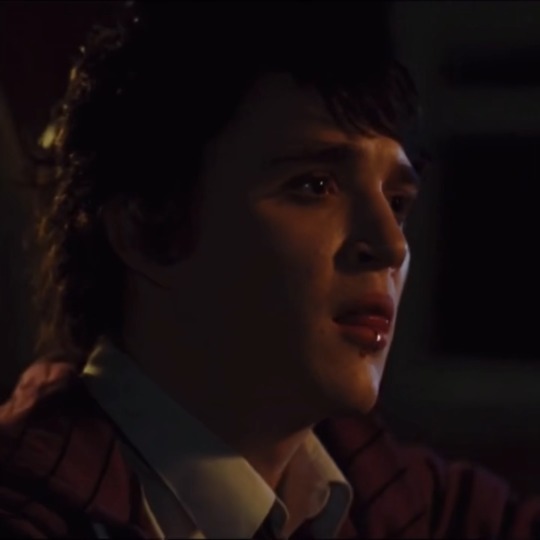







colin gray icons 🎧🖤💿
like if you save
#film icons#icons#colin gray icons#jennifers body icons#jennifer’s body icons#no psd icons#emo icons
35 notes
·
View notes
Text
There was a new band that was rising in fame recently. Colin had been following them from when they released their first song. Low Shoulder was the name of the band. Colin listened to their music as a guilty pleasure, he even lied to his goth boy clique that he was at a graveyard tonight. That was a lie to keep his pride; Colin was actually at a small ( and rather shitty ) bar in town called The Carousel. It was a rundown filthy little place that others gathered in for fun. The blue-eyed guy nervously fidgeted with the band bracelets on his wrist. He gave a small smile crossed with a smirk to the lead singer as he approached the stage.
❝ 𝙃𝙚𝙮, ❞ He immediately scolded himself on the lack of uniqueness in the greeting.
❝ sorry, I really like the music that you put out. It’s 𝘪𝘯𝘴𝘱𝘪𝘳𝘢𝘵𝘪𝘰𝘯𝘢𝘭. ❞ His eyes shined brightly in adoration as he stared up to Nikolai Wolf. He looked up to the guy completely awestruck. Nikolai was talking back, but he didn’t register any of it. His heart was racing too fast from meeting one of his idols. It felt like he was living a dream come true, and Colin never thought he would feel that in his life. He was fanboying over a group, and normally he would be opposed to putting others on a pedestal.

#jennifer’s body rp#roleplay#jennifer’s body#colin gray#colin gray roleplay#≪ °🖤° ≫ 𝙳𝚁𝙰𝙱𝙱𝙻𝙴𝚂 + 𝚂𝙰𝙼𝙿𝙻𝙴𝚂 ᴄᴏʟɪɴ#also not really feeling this one I like the text bold tho#there needs to be a subtle transition#from the dialogue to the inner monologue#kinda like the icon thing for the page break tho#wait kinda cute tho?? the RING
10 notes
·
View notes
Text
if i don’t look like the goth boy from jennifer’s body (2009) then WHAT’S the point
3K notes
·
View notes
Text
Listen I have ABSOLUTELY NO IDEA how Kyle Gallner identifies but I LOVE that most of us fans are queer and that we’ve collectively latched onto all his characters as queer icons especially our lord and savior Colin Gray. 🙏🏻
84 notes
·
View notes
Link
BY JANELLE OKWODU
There are plenty of notable British celebrities, but Hugh Grant and Colin Firth are in a class by themselves. The heartthrobs of mid-’90s period pieces are not interchangeable—try to imagine Firth mooning over Julia Roberts in Notting Hill or Grant belting out ABBA in Mamma Mia, it doesn’t work—and they share a special place in pop culture. Both capable of adding new verve to Austen heroes, courting Bridget Jones, and looking damn good in a suit, the actors, who turn 60 this week, serve as benchmarks for British style onscreen and off.
Older by precisely one day, Grant has embodied the term dashing for four decades. Emerging in the ’90s, all floppy hair and boyish smile, he was a posh alternative to the decade’s grunge pinups. You were not going to spot Hugh Grant in a frayed flannel at a Pearl Jam concert. Instead, Grant helped to bring a polished sensibility back to the red carpet. These days every actor in Hollywood has a stylist and a fashion philosophy, but circa 1995 that wasn’t the case. Dressing down was considered the height of cool, and it wasn’t uncommon for male celebrities to arrive looking undone at parties and premieres. While his contemporaries indulged an arrested development of baggy jeans and leather jackets, Grant, in his pinstriped suits and perfectly tailored jackets, was the designated grownup.
The sophistication of Grant’s wardrobe aligned with his image as a worldly leading man. It would be sacrilege if the guy who cut his teeth on Merchant-Ivory adaptations and descended from Sir Walter Raleigh didn’t know how to wear a suit. His comic heroes weren’t always dressed up, but they didn’t default into Gen-X style ambivalence. If anything, their casual-chic (think: Daniel Cleaver and his perpetually unbuttoned shirts, Love Actually’s inexplicably attractive Prime Minister) added another layer of good taste.
Firth’s fashion moment came later in life. Sure, he was handsome in the ’90s—it would take a concerted effort to make him look bad—though it’s clear Tom Ford’s influence elevated things considerably. Where Mr. Darcy had his damp blouse, Firth has a never-ending selection of Ford designed suits that fit like a glove. A fan of the classics, he sticks to a palette of gray, black, and navy, and avoids unnecessary flourishes. While it would be nice to see him in, say, a metallic Dior Men cape, and matching brogues, there’s something to be said for consistency. Firth knows what works for him and doesn’t need to attempt the latest trends.
That classicism carries over into his onscreen persona. His Kingsman franchise is the most fashion adjacent action series since James Bond. The immaculate double-breasted King & Allen suits worn by his super-spy character, Harry Hart, double as weapons. But more than that they signal the character’s debonair nature. Any competent action hero can take down a room full of bad guys, but to do it in Saville Row fit and tortoiseshell glasses without breaking a sweat? Manners maketh man, indeed.
Despite the differences, Firth and Grant’s takes on fashion share an understated quality. With their affinity for tailoring and tradition they adhere to the hallmarks of fantastic menswear. Still, ultimately clothes aren’t as important as the dapper vibe they project and its impact on those around them. The runway looks and custom-made sustainable gowns favored by their respective partners and co-stars are what makes the headlines. When Elizabeth Hurley stepped out in that oft-imitated safety pin Versace gown at the 1994 premiere of Four Weddings and a Funeral, Grant could have been stark naked, and no one would have noticed, even though he was wearing an excellent Versace suit that night. Likewise, no one could drag the spotlight away from Julianne Moore in liquid metal Tom Ford at the Kingsman: Golden Circle premiere back in 2017. In his slate suit and tie, Firth complemented his leading lady. Like a gold band that makes a diamond look brighter, both stars keep things simple so the women in their lives can shine—and what’s more gentlemanly than that?
9 notes
·
View notes
Text
LGBTQ Book & Film Recommendations
Hello! As someone who tries to read widely, it can sometimes be frustrating to find good (well-written, well-made) LGBTQ+ works of literature and film, and mainstream recommendations only go so far. This is my shortlist.
Some caveats:
1) I have only watched/seen some of these, though they have all been well-received.
2) The literature list is primarily focused on adult literary and genre fiction, since that is what I mostly read, and I feel like it’s easier to find queer YA fiction. Cece over at ProblemsOfABookNerd (YT) covers a lot of newer releases and has a YA focus, so you can check her out for more recommendations.
3) There are a ton of good films and good books that either reference or discuss queer theory, LGBTQ history and literary theory. These tend to be more esoteric and academic, and I’m not too familiar with queer theory, so they’ve largely been left off the list. I do agree that they’re important, and reading into LGBTQ-coding is a major practice, but they’re less accessible and I don’t want to make the list too intimidating.
4) I linked to Goodreads and Letterboxd because that’s what I use and I happen to really enjoy the reviews.
Any works that are bolded are popular, or they’re acclaimed and I think they deserve some attention. I’ve done my best to flag potential objections and triggers, but you should definitely do a search of the reviews. DoesTheDogDie is also a good resource. Not all of these will be suitable for younger teenagers; please use your common sense and judgement.
Please feel free to chime in in the replies (not the reblogs) with your recommendations, and I’ll eventually do a reblog with the additions!
BOOKS
> YOUNG ADULT
Don’t @ me asking why your favourite YA novel isn’t on this list. These just happen to be the picks I felt might also appeal to older teens/twentysomethings.
Aristotle and Dante Discover the Secrets of the Universe
Clap When You Land by Elizabeth Acevedo - poetry.
Felix Ever After by Kacen Callender - trans male teen protagonist.
Red, White & Royal Blue
Simon vs the Homo Sapiens Agenda
The Gentleman’s Guide To Vice And Virtue
The Raven Boys (and Raven Cycle)
> LITERATURE: GENERAL
This list does skew M/M; more NB, trans and WLW recommendations are welcomed!
A Little Life by Hanya Yanagihara. One of the most acclaimed contemporary LGBTQ novels and you’ve probably heard of it. Will probably make you cry.
A Single Man by Christopher Isherwood. Portrait of a middle-aged gay man.
Brideshead Revisited by Evelyn Waugh. M/M affair, British student high society; definitely nostalgic for the aristocracy so be aware of the context.
Call Me By Your Name by André Aciman. It’s somewhat controversial, it’s gay, everyone knows the film at least.
Cronus’ Children / Le Jardin d'Acclimation by Yves Navarre. Winner of the Goncourt prize.
Dancer From The Dance by Andrew Holleran. A young man in the 1970s NYC gay scene. Warning for drugs and sexual references.
Dorian, An Imitation by Will Self. Adaptation of Orscar Wilde’s novel. Warning for sexual content.
Fried Green Tomatoes at the Whistle Stop Cafe by Fannie Flagg. Two wlw in the 1980s. Also made into a film; see below.
Gemini by Michel Tournier. The link will tell you more; seems like a very complex read. TW for troubling twin dynamics.
Giovanni’s Room by James Baldwin. Another iconic M/M work.
Lost Boi by Sassafras Lowrey. A queer punk reimagining of Peter Pan. Probably one of the more accessible works on this list!
Lie With Me by Philippe Besson. Two teenage boys in 1980s France.
Maurice by E. M. Forster. Landmark work written in 1914. Also made into a film; see below.
Middlesex by Jeffrey Eugenides. An expansive (and long) novel about the story of Cal, a hermaphrodite, by the author of The Virgin Suicides.
Orlando by Virginia Woolf. Plays with gender, time and space. Virginia Woolf’s ode to her lover Vita Sackville-West. What more do you want? (also a great film; see below).
Oscar Wilde’s works - The Picture of Dorian Gray would be the place to start. Another member of the classical literary canon.
Saga, vol.1 by Brian K. Vaughn and Fiona Staples. Graphic novel; warning for sexual content.
Stone Butch Blues by Leslie Feinburg. An acclaimed work looking at working-class lesbian life and gender identity in pre-Stonewall America.
The Holy Innocents by Gilbert Adair. The basis for Bertolucci’s The Dreamers (2003). I am hesitant to recommend this because I have not read this, though I have watched the film; the M/M dynamic and LGBTQ themes do not seem to be the primary focus. Warning for sexual content and incestuous dynamics between the twins.
The Animals At Lockwood Manor by Jane Healey. Plays with gothic elements, set during WW2, F/F elements.
The Hours by Michael Cunningham. References Woolf’s Mrs Dalloway. Probably a good idea to read Virginia Woolf first.
The Immoralist by André Gide. Translated from French.
The Song of Achilles by Madeline MIller. Drawing from the Iliad, focusing on Achilles and Patroclus. Contemporary fantasy that would be a good pick for younger readers.
The Swimming Pool Library by Alan Hollinghurst. Gay life pre-AIDS crisis. Apparently contains a fair amount of sexual content.
What Belongs To You by Garth Greenwell. A gay man’s coming of age in the American South.
> LITERATURE: WORLD LITERATURE
American and Western experiences are more prominent in LGBTQ works, just due to the way history and the community have developed, and the difficulties of translation. These are English and translated works that specifically foreground the experiences of non-White people living in (often) non-Western societies. I’m not white or American myself and recommendations in this area are especially welcomed.
All Boys Aren’t Blue by George M. Johnson. The memoirs and essays of a queer black activist, exploring themes of black LGBTQ experiences and masculinity.
A People’s History of Heaven by Mathangi Subramanian. Female communities and queer female characters in a Bangalore slum. A very new release but already very well received.
Confessions of a Mask by Yukio Mishima. Coming-of-age in post-WW1 Japan. This one’s interesting, because it’s definitely at least somewhat autobiographical. Mishima can be a tough writer, and you should definitely look into his personality and his life when reading his work.
Disoriental by Négar Djavadi. A family saga told against the backdrop of Iranian history by a queer Iranian woman. Would recommend going into this knowing at least some of the political and historical context.
How We Fight For Our Lives by Saeed Jones. A coming-of-age story and memoir from a gay, black man in the American South.
In The Dream House by Carmen Maria Machado. Another acclaimed contemporary work about the dynamics of abuse in LGBTQ relationships. Memoir.
Girl, Woman, Other by Bernardine Evaristo. Contemporary black British experience, told from the perspectives of 12 diverse narrators.
> POETRY
Crush by Richard Siken. Tumblr loves Richard Siken, worth a read.
Diving Into The Wreck by Adrienne Rich.
He’s So Masc by Chris Tse.
If Not, Winter: Fragments of Sappho, trans. Anne Carson. The best presentation of Sappho we’re likely to get.
Lord Byron’s works - Selected Poems may be a good starting point. One of the Romantics and part of the classical literary canon.
Les Fleurs du Mal by Charles Baudelaire. The explicitly lesbian poems are apparently in the les fleurs du mal section.
> MEMOIR & NONFICTION
And The Band Played On: Politics, People and the AIDS Epidemic by Randy Shilts. An expansive, comprehensive history and exposure of the failures of media and the Reagan administration, written by an investigative journalist. Will probably make you rightfully angry.
How to Survive A Plague: The Inside Story of How Citizens and Science Tamed AIDS by David France. A reminder of the power of community and everyday activism, written by a gay reporter living in NYC during the epidemic.
Indecent Advances: The Hidden History of Murder and Masculinity Before Stonewall by James Polchin. True crime fans, this one’s for you. Sociocultural history constructed from readings of the news and media.
Queer: A Graphic History by Meg-John Barker. It’s illustrated, it’s written by an academic, it’s an easier introduction to queer theory. I still need to pick up a copy, but it seems like a great jumping-off point with an overview of the academic context.
Real Queer America by Samantha Allen. The stories of LGBTQ people and LGBTQ narratives in the conservative parts of America. A very well received contemporary read.
The Argonauts by Maggie Nelson. Gender, pregnancy and queer partnership. I’m not familiar with this but it is quite popular.
When Brooklyn Was Queer by Hugh Ryan. LGBTQ history of Brooklyn from the nineteenth century to pre-Stonewall.
FILMS
With films it’s difficult because characters are often queercoded and we’re only now seeing films with better rep. This is a shortlist of better-rated films with fairly explicit LGBTQ coding, LGBTQ characters, or made by LGBTQ persons. Bolded films are ones that I think are likely to be more accessible or with wider appeal.
A Single Man (2009) - Colin Firth plays a middle-aged widower.
Blue Is The Warmest Colour (2013) - A controversial one. Sexual content.
Booksmart (2019) - A pretty well made film about female friendship and being an LGBTQ teen.
Boy Erased (2018) - Warning for conversion therapy.
BPM (Beats Per Minute) (2017) - Young AIDS activists in France.
Brokeback Mountain (2005) - Cowboy gays. This film is pretty famous, do you need more summary? Might make a good triple bill with Idaho and God’s Own Country.
Cabaret (1972) - Liza Minelli. Obvious plug to also look into Vincent Minelli.
Calamity Jane (1953) - There’s a lot that could be said about queer coding in Hollywood golden era studio films, but this is apparently a fun wlw-cowboy westerns-vibes watch. Read the reviews on this one!
Call Me By Your Name (2017) - Please don't debate this film in the notes.
Caravaggio (1986) - Sean Bean and Tilda Swinton are in it. Rather explicit.
Carol (2015) - Cate Blanchett and Rooney Mara are lesbians in 1950s America.
Clouds of Sils Maria (2014) - Hard to summarise, but one review calls it “lesbian birdman” and it has both Juliette Binoche and Kristen Stewart in it, so consider watching it.
Colette (2018) - About the bi/queer female writer Colette during the belle epoque era. This had Keira Knightley so by all rights Tumblr should love it.
Fried Green Tomatoes (1991) - Lesbian love in 1920s/80s? America.
God’s Own Country (2017) - Gay and British.
Happy Together (1997) - By Wong Kar Wai. No further explanation needed.
Heartbeats (2010) - Bi comedy.
Heartstone (2016) - It’s a story about rural Icelandic teenagers.
Henry Gamble’s Birthday Party (2015) - Queer teens and religious themes.
Je, Tu, Il, Elle (1974) - Early Chantal Akerman. Warning for sexual scenes.
Kill Your Darlings (2013) - Ginsberg, Kerouac and the Beat poets.
Love, Simon (2018)
Lovesong (2016) - Lesbian and very soft. Korean-American characters.
Love Songs (2007) - French trio relationship. Louis Garrel continues to give off non-straight vibes.
Mädchen In Uniform (1931) - One of the earliest narrative films to explicitly portray homosexuality. A piece of LGBTQ cinematic history.
Maurice (1987) - Adaptation of the novel.
Midnight Cowboy (1969) - Heavy gay coding.
Milk (2008) - Biopic of Harvey Milk, openly gay politician. By the same director who made My Own Private Idaho.
Moonlight (2016) - It won the awards for a reason.
My Own Private Idaho (1991) - Another iconic LGBTQ film. River Phoenix.
Mysterious Skin (2004) - Go into this film aware, please. Young actors, themes of prostitution, child ab*se, r***, and a lot of trauma.
Orlando (1992) - An excellent adaptation of Virginia Woolf’s novel, and in my opinion far more accessible. Watch it for the queer sensibilities and fantastic period pieces.
Pariah (2011) - Excellent coming-of-age film about a black lesbian girl in Brooklyn.
Paris is Burning (1990) - LANDMARK DOCUMENTARY piece of LGBTQ history, documenting the African-American and Latine drag and ballroom roots of the NYC queer community.
Persona (1966) - It’s an Ingmar Bergman film so I would recommend knowing what you’re about to get into, but also I can’t describe it because it’s an Ingmar Bergman film.
Picnic At Hanging Rock (1975) - Cult classic queercoded boarding school girls.
Portrait of a Lady on Fire (2019) - By Celine Sciamma, who’s rapidly establishing herself in the mainstream as a LGBTQ film director. This is a wlw relationship and the queer themes are reflected in the cinematic techniques used. A crowd pleaser.
Pride (2014) - Pride parades with a British sensibility.
Rebel Without A Cause (1955) - Crowd-pleaser with bi coding and James Dean. The OG version of “you’re tearing me apart!”.
Rocketman (2019) - It’s Elton John.
Rent (2005) - Adaptation of the stage musical. Not the best film from a technical standpoint. I recommend the professionally recorded 2008 closing night performance instead.
Rope (1948) - Hitchcock film.
Sorry Angel (2018) - Loving portraits of gay French men.
Talk To Her (2002) - By Spanish auteur Pedro Almodóvar.
Tangerine (2015) - About trans sex workers. The actors apparently had a lot of input in the film, which was somehow shot on an iPhone by the same guy who went on to do The Florida Project.
The Duke of Burgundy (2014) - Lesbians in an S&M relationship that’s going stale, sexual content obviously.
The Gay Deceivers (1969) - The reviews are better than me explaining.
The Handmaiden (2016) - Park Chan-wook makes a film about Korean lesbians and is criminally snubbed at the Oscars. Warning for sexual themes and kink.
The Favourite (2018) - Period movie, and lesbian.
Thelma And Louise (1991) - An iconic part of LGBTQ cinematic history. That is all.
The Celluloid Closet (1995) - A look into LGBTQ cinematic history, and the historical contexts we operated in when we’ve snuck our narratives into film.
The Miseducation of Cameron Post (2018) - Adaptation of the YA novel.
The Neon Demon (2016) - Apparently based on Elizabeth Bathory, the blood-drinking countess. Very polarising film and rated R.
The Perks of Being A Wallflower (2012) - Book adaptation. It has Ezra Miller in it I guess.
The Rocky Horror Picture Show (1975) - No explanation needed, queer and transgressive vibes all the way.
They (2017) - Gender identity, teenagers.
Those People (2015) - They’re gay and they’re artists in New York.
Tomboy (2011) - One of the few films I’ve seen dealing with gender identity in children (10 y/o). Celine Sciamma developing her directorial voice.
Tropical Malady (2004) - By Thai auteur Apichatpong Weerasethakul. His is a very particular style so don’t sweat it if you don’t enjoy it.
Vita and Virginia (2018) - Virginia Woolf and Vita Sackville-West biopic
Water Lilies (2007) - Celine Sciamma again! Teenage lesbian coming-of-age.
When Marnie Was There (2014) - A Studio Ghibli film exploring youth, gender and sexuality.
Weekend (2011) - An indie film about young gay love.
Wilde (1997) - It’s a film about Oscar Wilde.
XXY (2007) - About an intersex teenager. Reviews on this are mixed.
Y Tu Mama Tambien (2001) - Wonder what Diego Luna was doing before Rogue One? This is one of the things. Warning for sexual content.
#dark academia#book recommendations#film recommendation#lgbtq fiction#lgbtq film#lgbtq books#queer fiction#queer film#lgbtq#lgbt fiction#lgbt representation#queer representation#lgbt film#bookblr#filmblr#mlm#wlw#nblm#nblw#trans representation#richard siken#sappho#oscar wilde#lord byron#poc representation#lgbtq poc representation#literature#the library#mine#wildeoaths masterpost
24 notes
·
View notes
Text
I’m sorry, but Piper and Colin Greenmantle discussing cheese and crackers while the Gray Man has a gun to Piper’s head? Iconic.
-Please tag & credit @therandomfandomgal
#the raven boys#the raven cycle#piper greenmantle#collin greenmantle#gansey#ronan lynch#blue sargent#adam parrish#the gray man#the greywarren#the graywarren
10 notes
·
View notes
Text
Thanks @merlinmyrddin for the tag:)
Ten characters from ten fandoms:
What, only ten? Well, no one promised that it will be easy...
0) Merlin (Colin Morgan) from ‘Merlin’, because it’s obvious and I know how to cheat ;)

Art by AmandaTolleson
1) Spock (Zackary Quinto) from ‘Star Trek Reboot’ because I’m sapiosexual

2) Spencer Reid (Matthew Gray Gubler) from ‘Criminal Minds’, same reason
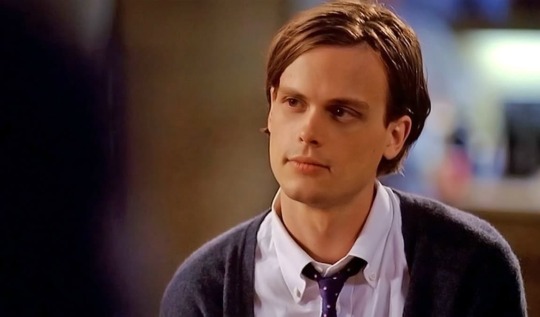
3) Q (Ben Whishaw) from ‘James Bond’, same reason... Ben Whishaw is the best thing that could have happen with ‘Bond’ franchise, they are blessed. And these british cheekbones should be forbidden on the aircrafts because it’s a weapon. Honestly, what is this with british actors and their cheekbones?!

4) James McGraw aka Flint (Toby Stephens) from ‘Black Sails’ because his determination wins over seas and horrids of human nature. Also: how to make a proper non-heterosexual male character

5) Karen Page (Deborah Ann Woll) from ‘Daredevil’ because she’s a fighter, and Deborah Ann Woll is some kind of a goddess

6) Anne Lister (Suranne Jones) from ‘Gentleman Jack’ because she doesn’t give a damn about stupid social conventions
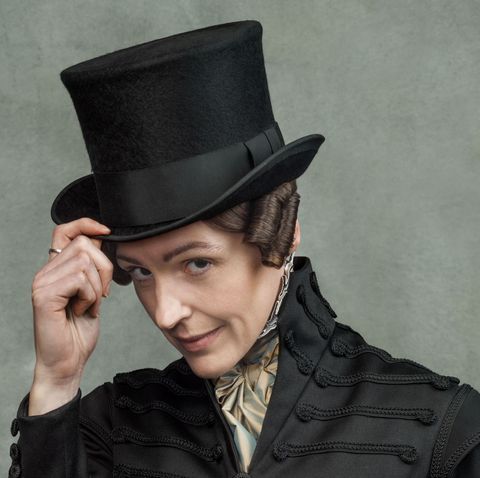
7) Joss Carter (Taraji Henson) from ‘Person of Interest’ because she’s manages to be both a BAMF and one of the kindest souls. Also the whole main cast of PoI should be in this list, to be honest, because I’m in love with all of them

7) Kara Thrace aka Starbuck’ (Katee Sackhoff) from ‘Battlestar Galactica’ because she’s the most realistic superhero I’ve ever seen. Also I cried when she disappeared in the series ending, and I don’t cry. Ever.

9) Elizabeth Weir (Torri Higginson) from ‘Stargate Atlantis’ because I’d love to see all diplomats and leaders to be like her.

10) Dana Scully (Gillian Anderson) from ‘X-Files’ because she’s more or less an iconic fictional female scientist

Damn, I forgot how much I love them all. Now I want to rewatch it all. Stargate, Battlestar Galactica, Criminal Minds, PoI, X-Files... It would be like 50 seasons in total xD
Feel free to pick up the tag:).
3 notes
·
View notes
Text
Language of the Unheard
Events currently unfolding in the United States may resemble a sudden explosion to some, but the undercurrent carrying this new wave of civil unrest has been traveling since the Western country’s inception. Although African Americans have been an integral part of the fabric of American culture, they remain some of the country’s most marginalized people, as reflected in disparities in wealth, education, healthcare, housing, and civil rights. Public awareness of the adverse relationship between American law enforcement and its black citizenry is at an all time high. With the advent of social media and smartphones, incidents of police brutality have become more visible as striking videos are shared around the world, shedding light on the atrocities black people have been subject to. Although there have been cries for more accountability from police when these incidents occur, they have fallen on deaf ears, and the resulting frustration has now built to a crescendo of turmoil all over the United States, the likes of which have not been seen for half a century.
The most recent of these grisly videos shows the killing of George Floyd at the hands of Derek Chauvin of the Minneapolis Police Department, who had already amassed 18 civilian complaints in his 18 year career as an officer. A store owner had called the police on George Floyd after reportedly, Floyd used a counterfeit $20 bill at his store. Video footage of the arrest which was published to the internet after the story went viral shows that Floyd was compliant with the arresting officers while being taken into custody. In the video of Floyd’s death however, we see that Floyd’s obedience didn’t save him. He is lying prone, face-down on the ground next to a police car with three officers pinning him down and Chauvin doing so by placing his knee over Floyd’s neck. Floyd pleads repeatedly “I can’t breathe” and begs the officer to stop, as do bystanders sympathetic with his plight. At one point in the video, Floyd seems to be delirious with fear and suffocation, even screaming for his mother who had died two years before. Officer Chauvrin kept his knee pressed to Floyd’s neck for a full 2 ½ minutes after Floyd lost consciousness. Authorities say he was pronounced dead at the hospital, but witnesses say that he died on that street. The four officers at the scene were eventually fired for committing acts that went against police policies, but it wasn’t until four days of nationwide protest calling for justice as a result of the viral video that Chauvrin was arrested and charged with murder.
Floyd’s murder is only the latest in a long series of murders committed by the police that traces back to the roots of the police as an entity in the United States, but has become more apparent with the use of technology that records the events as they happen. Many call the first incident of this kind in modern history the Rodney King incident, in which a black man was beaten mercilessly by the police on a Los Angeles freeway in 1991. This beating was far from an isolated incident, but it was one of the first of its kind to be caught on camera. Many black Americans at the time thought that the officers would be found guilty because it was such a flagrant display of police brutality. When the four officers that beat him were acquitted the next year, the streets of Los Angeles exploded in six days of civil unrest.
In the past 10 years there have been other notable cases that have made national headlines, such as Oscar Grant, Eric Garner, Freddy Gray, Breonna Taylor, Philando Castile, and Sandra Bland. These are just a few of the unarmed black people who were killed at the hands of the police. In all of the cases, the police involved in the killings went free without having served jail time, which is normal. Police often see themselves as having an adversarial relationship with black communities, and treat the people in those places as they would enemies in a war zone. In 2015 alone, over 100 unarmed black people were killed by law enforcement in America. Many such cases are never brought to trial, with the criminal justice system often finding a way to excuse the actions of the police without hearing the case out in court, even when the killings are recorded on video. Although black people make up only 12% of the American population, they are 2 ½ times more likely to be killed when having interactions with the police than their white counterparts. These incidents are a part of a cycle of death and protests that have not been successful in creating the kind of reforms that would answer to the killings of people in marginalized communities at the hands of police.
Peaceful protests of these extrajudicial killings have mostly fallen on deaf ears in the halls of law, and have even received resistance from American conservatives. Human rights movements like Black Lives Matter have emerged, organizing peaceful protests, and seeking to find new means of creating accountability for law enforcement officials. Famous American football quarterback Colin Kaepernick made international news when he began engaging in a silent protest of taking a knee during the playing of the National Anthem stating, “I am not going to stand up to show pride in a flag for a country that oppresses black people and people of color. To me, this is bigger than football and it would be selfish on my part to look the other way.” His silent protest and activism on the behalf of black people was met with derision, and he was eventually stripped of his ability to continue his sports career. We see that protests against police violence are scorned by many Americans, even when peaceful.
Although today iconic civil rights activist Martin Luther King is revered today as an example of the power of peaceful protest, when he was alive, he was widely disliked by most Americans. His daughter Bernice recently tweeted, “Don’t act like everyone loved my father. He was assassinated. A 1967 poll reflected that he was one of the most hated men in America. Most hated.” That poll reflected him having a 75% disapproval rating with Americans. The FBI at that time called King “ the most dangerous man in America.” King is known for influencing the signing of the Civil Rights Act, a tremendous step forward for black Americans at the time, but what is forgotten is that he tried for years to get it passed by the US government to no avail when he was killed in 1968. The outrage at the killing of King, a man who many African Americans saw as a bringer of peace, erupted in riots in cities across the United States. Within 6 days of the riots, President Lyndon B. Johnson signed the Civil Rights Act. King was a proponent of non-violent protest, but even he understood the nature of riots saying, “Certain conditions continue to exist in our society, which must be condemned as vigorously as we condemn riots. But in the final analysis, a riot is the language of the unheard.”
What will happen as a result of the civil unrest in the United States remains to be seen. The present situation exists in the context of the worst unemployment since the Great Depression, and a grossly mishandled global pandemic, which because of already existing disparities inequality, disproportionately affects black communities. Although the protests have been mostly peaceful, chaos has ensued at times, especially at night. Curfews are being enforced in many cities and police have been recorded attacking, pepper spraying and shooting rubber bullets at both looters and non-violent protesters.Video evidence is becoming viral that suggests that some of the violence is being propelled by agitators. President Trump has promised that protesters would be attacked with “vicious dogs and ominous weapons,” a threat that harkens back to the federal response to the civil rights movement in the 1960’s. It is yet to be seen when the smoke clears what the United States government and its people will do to get to the root of the underlying problems it faces related to race and police brutality.
1 note
·
View note